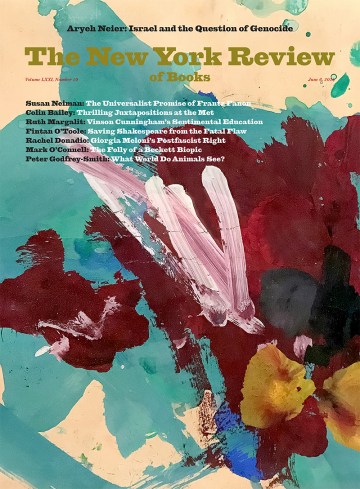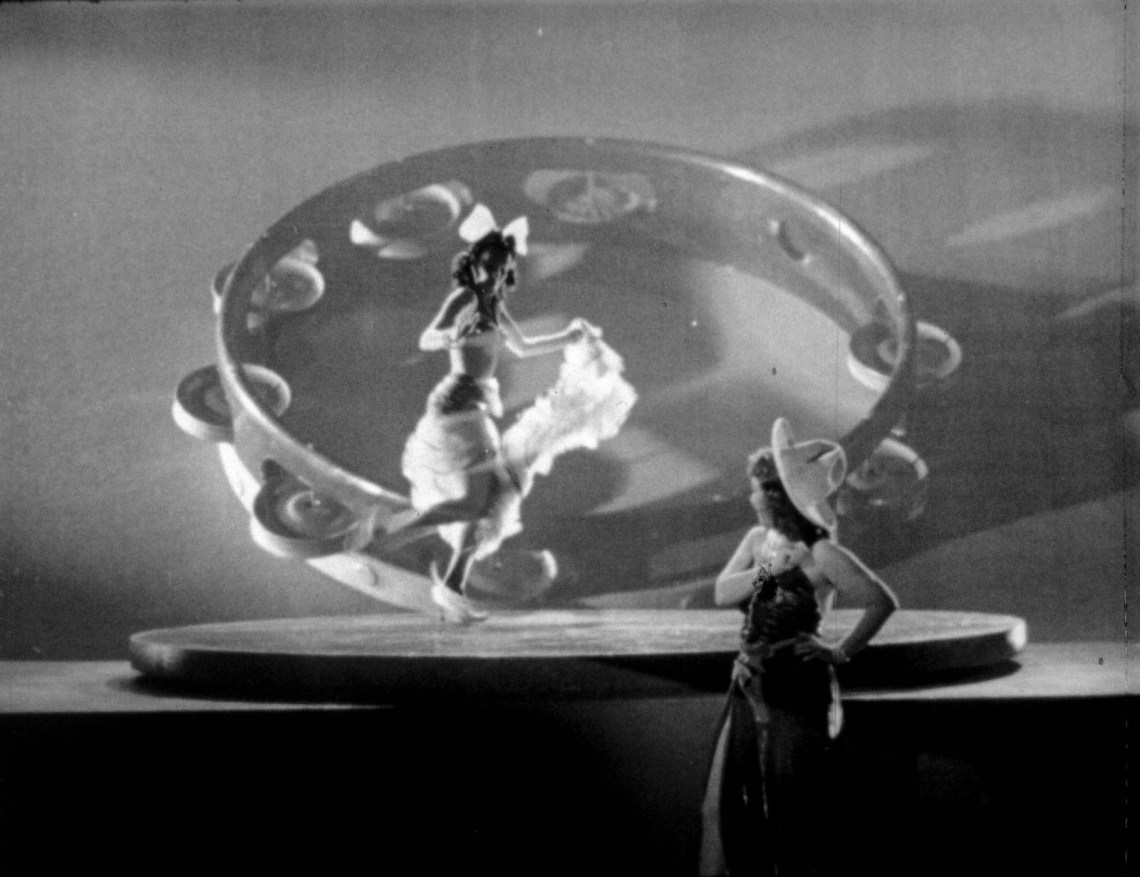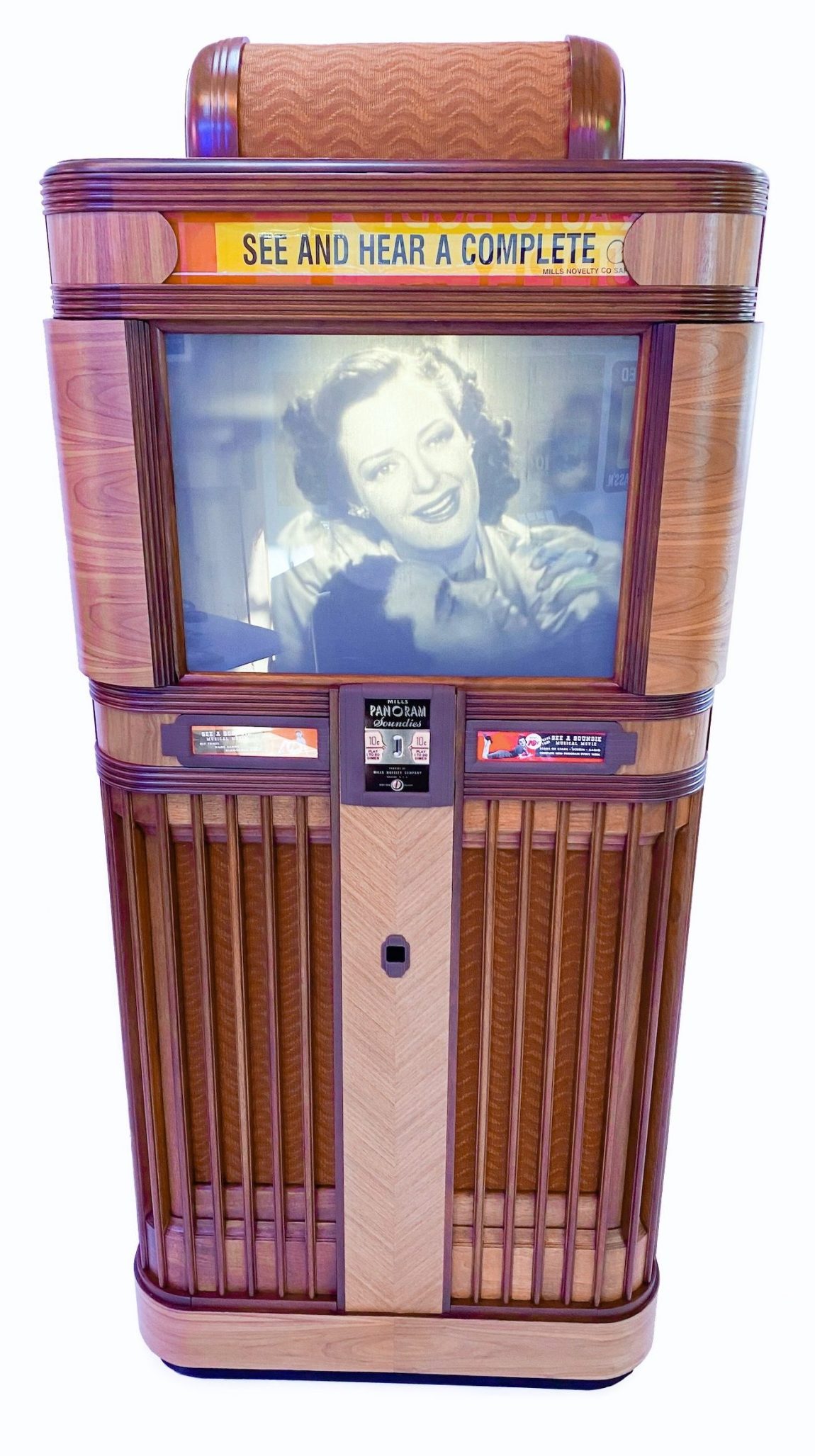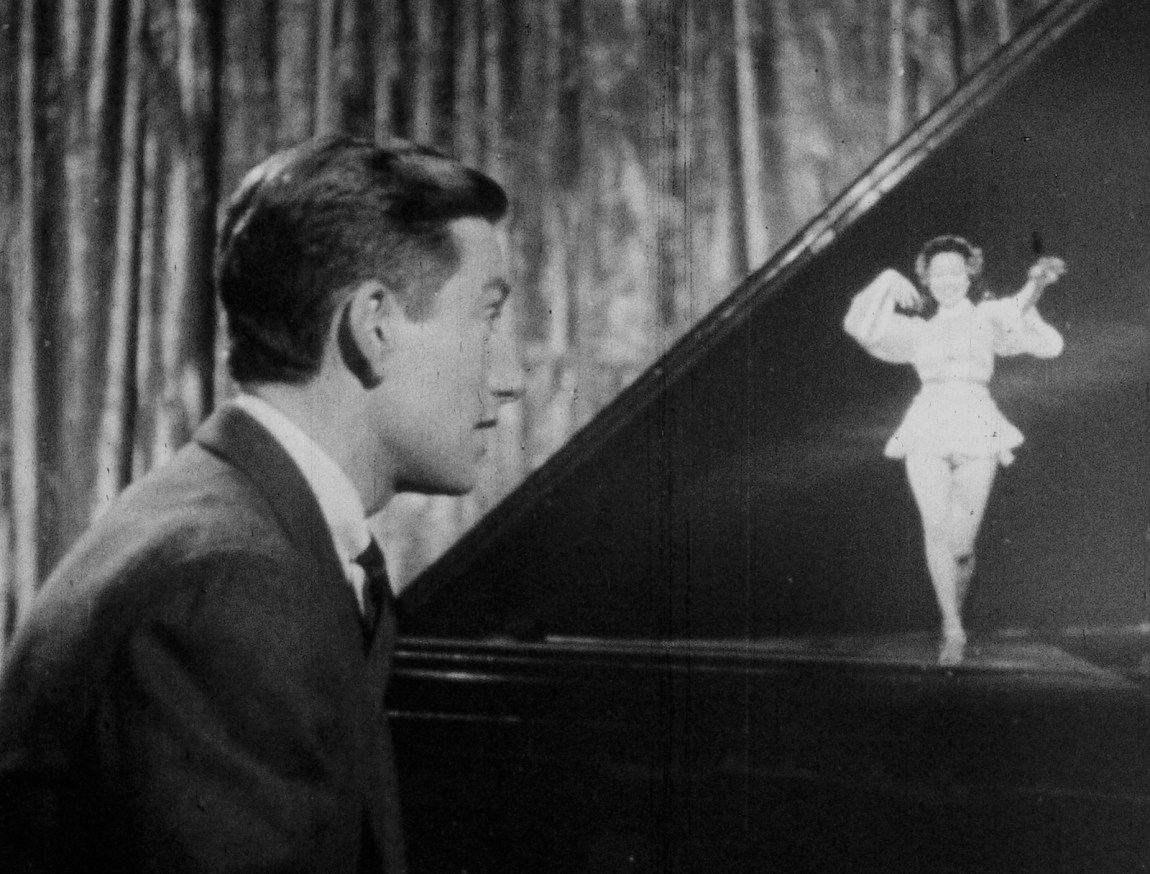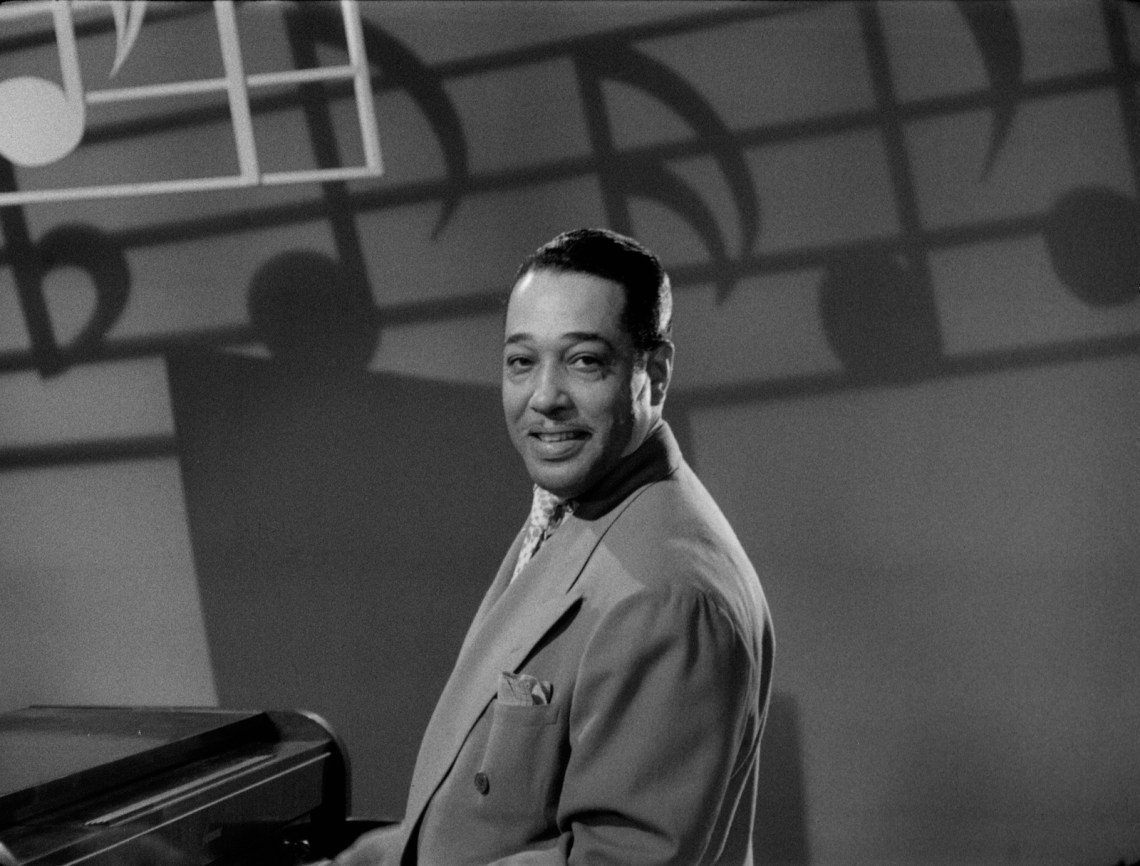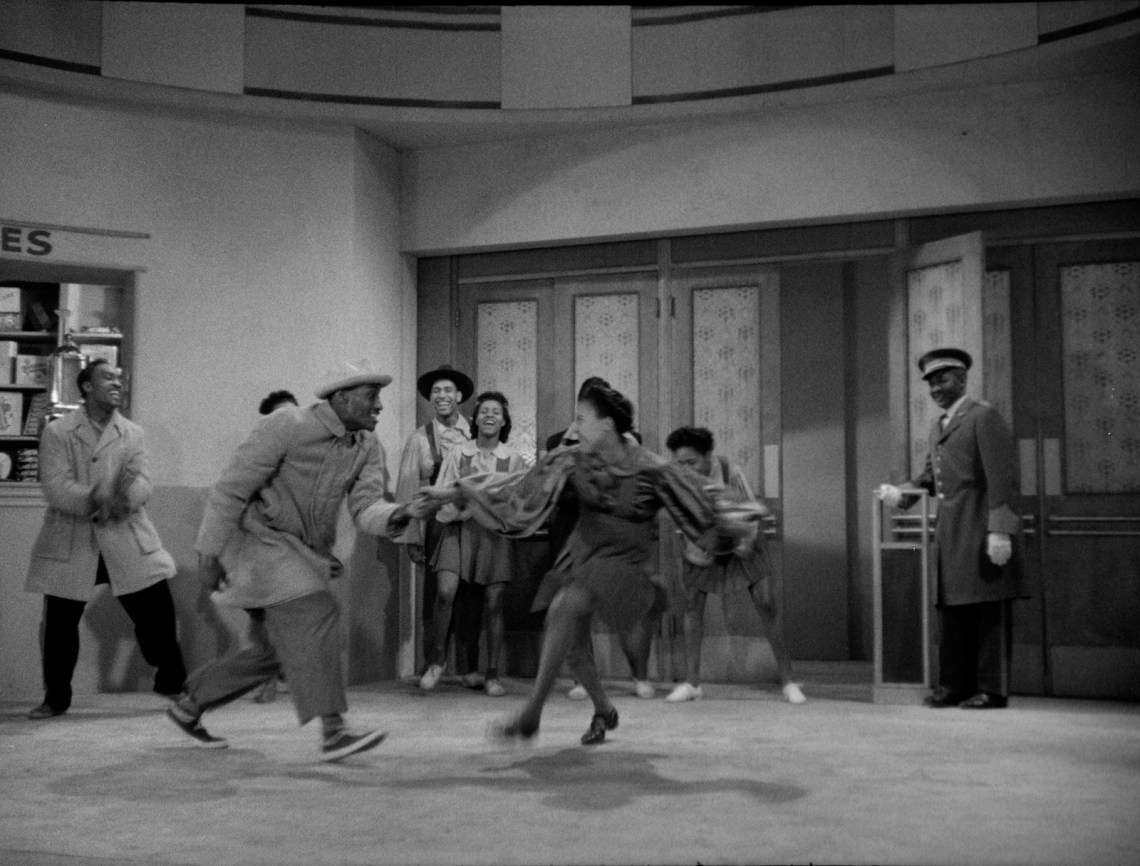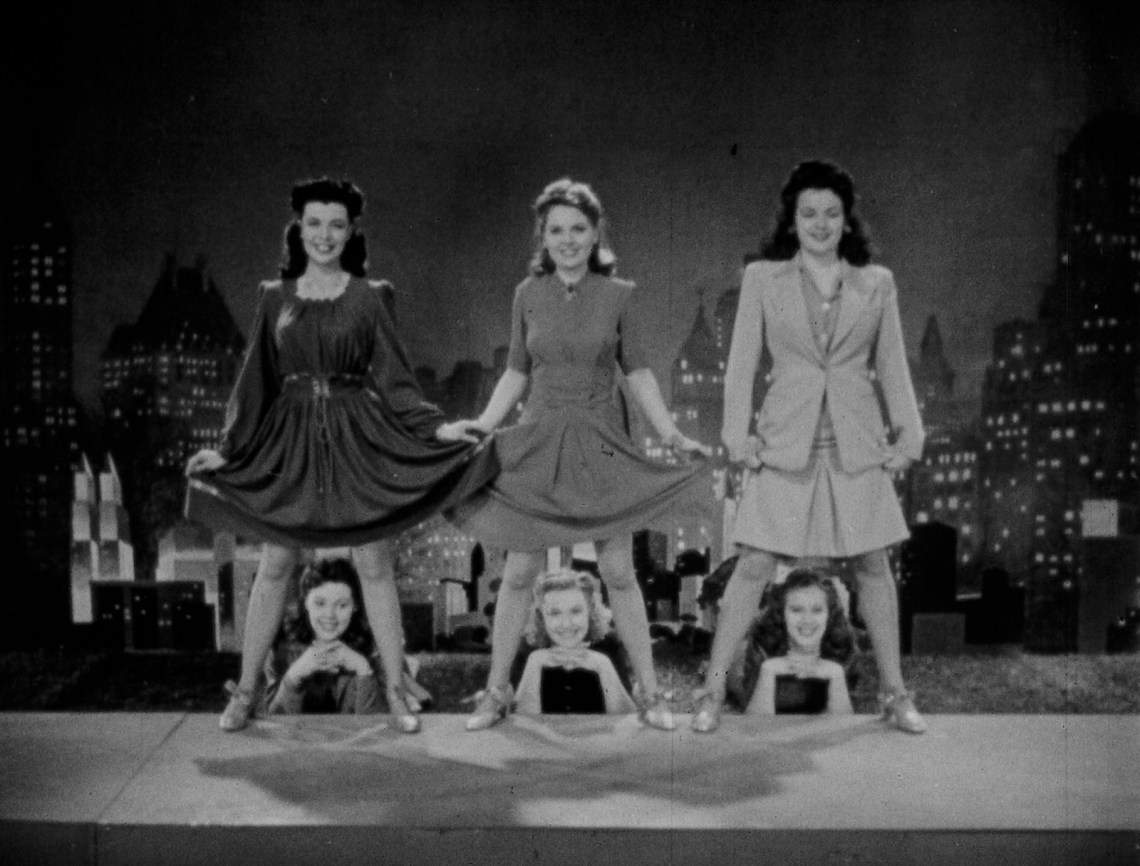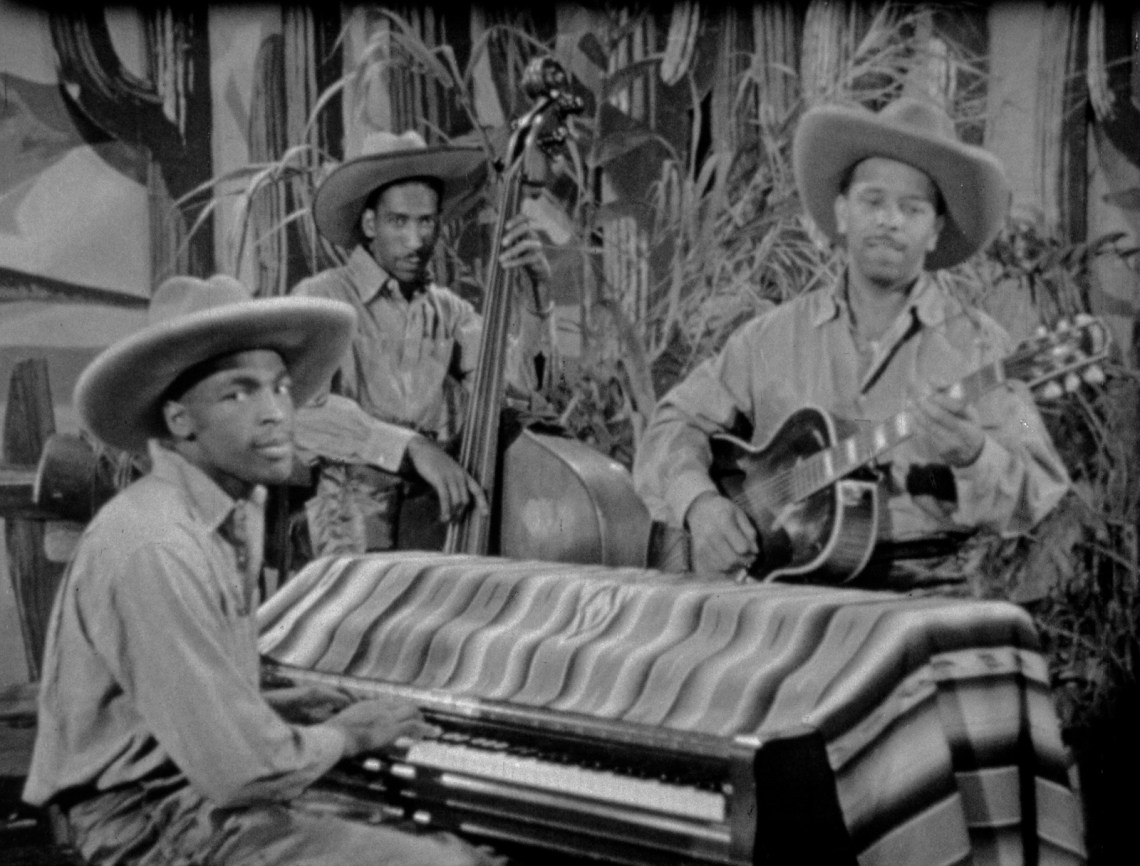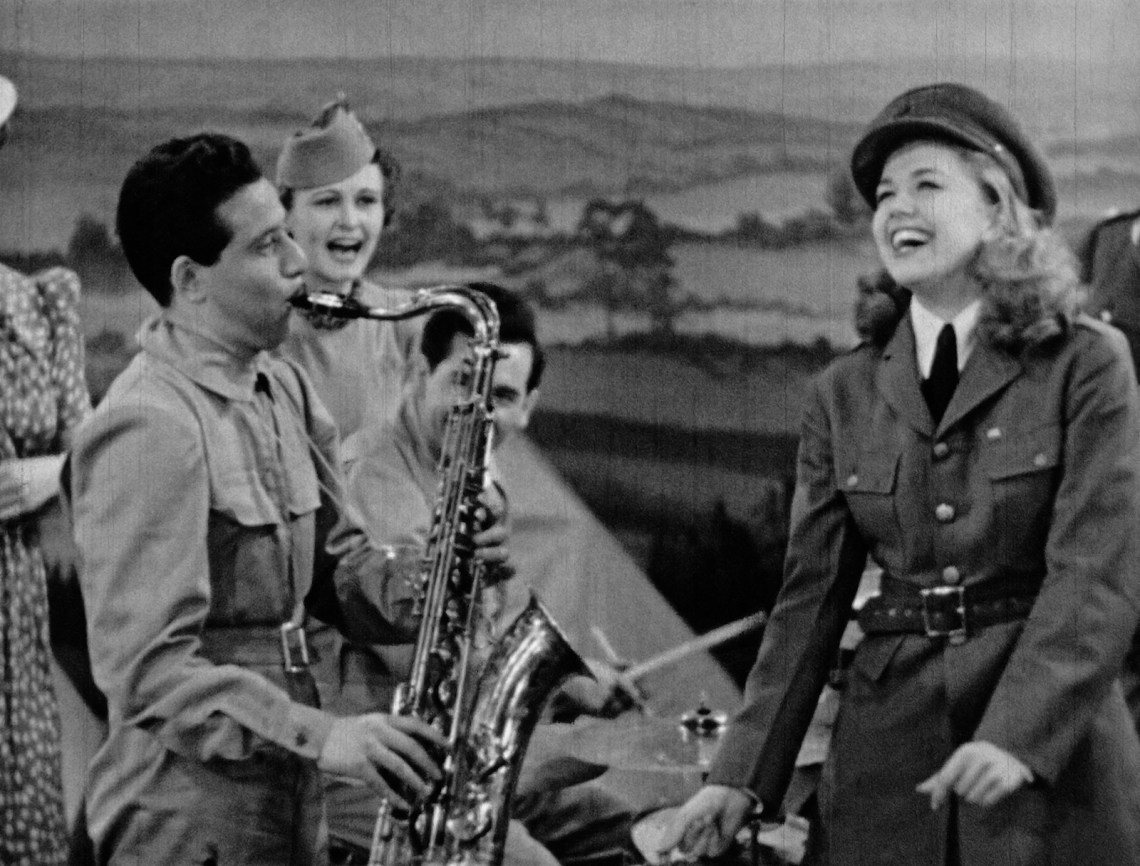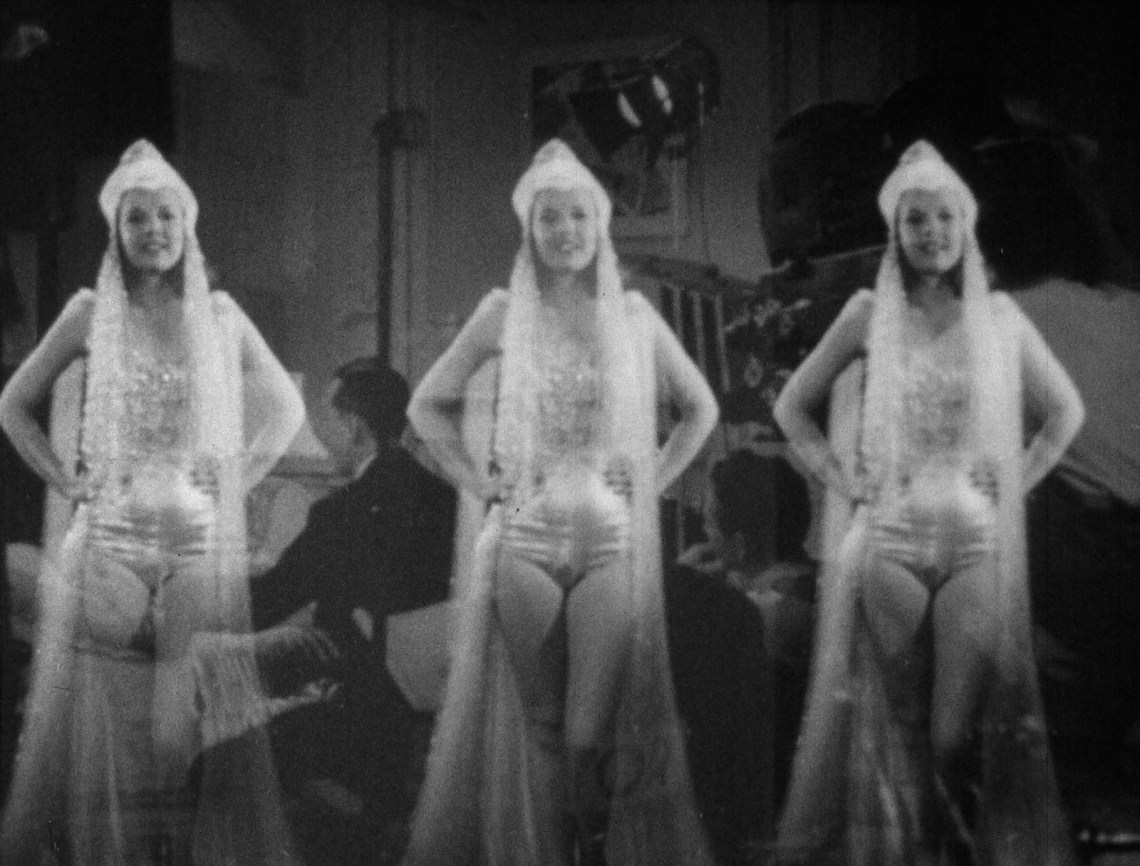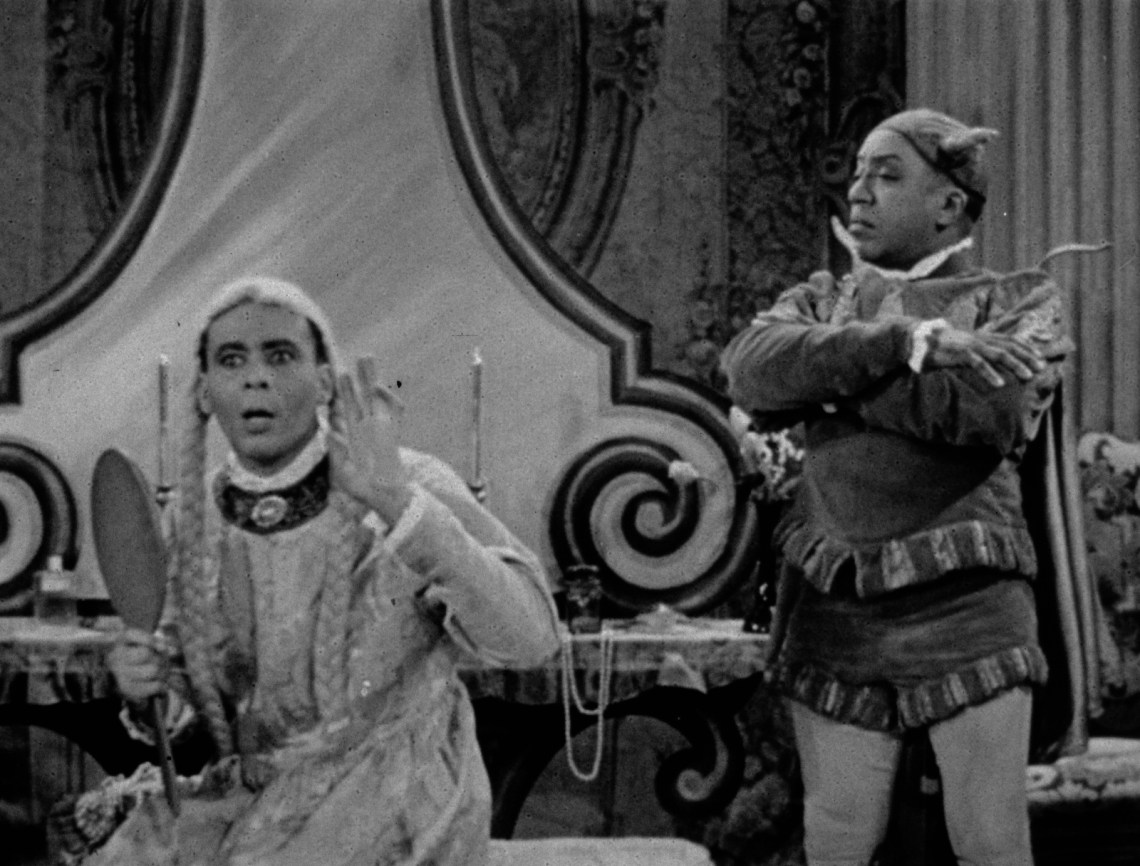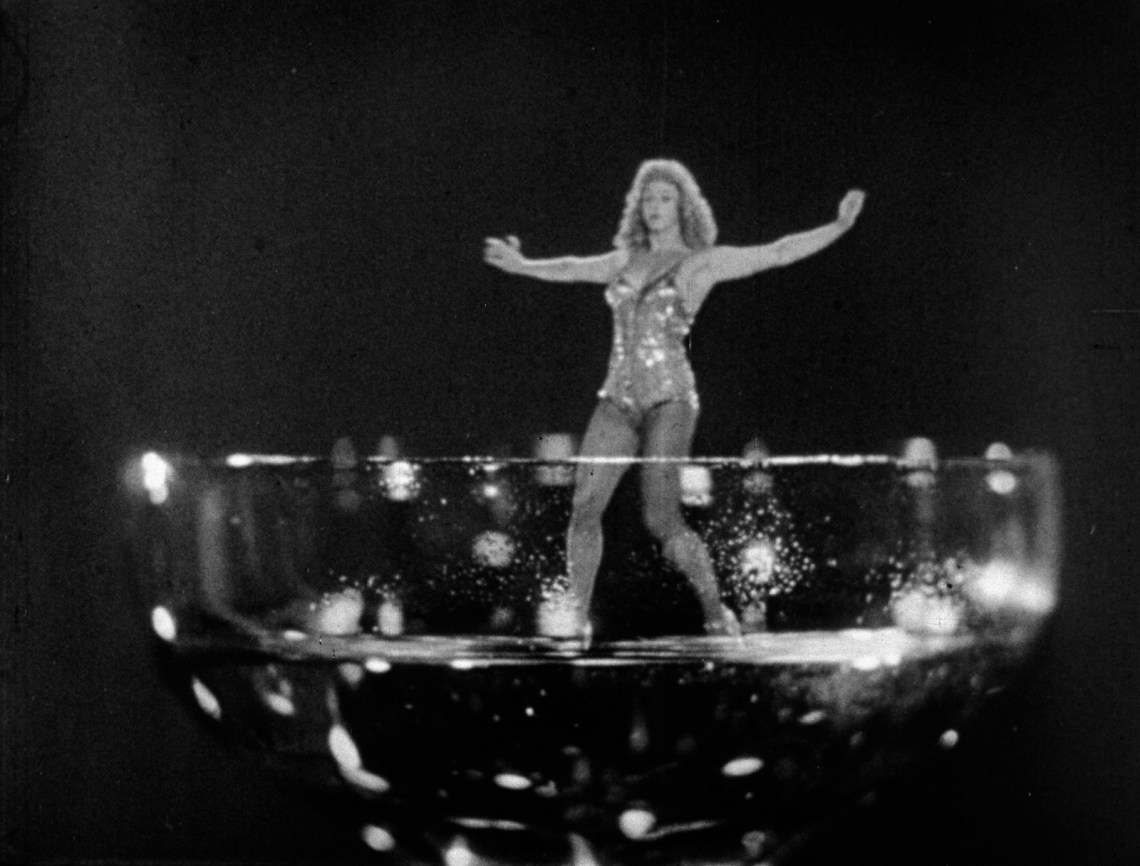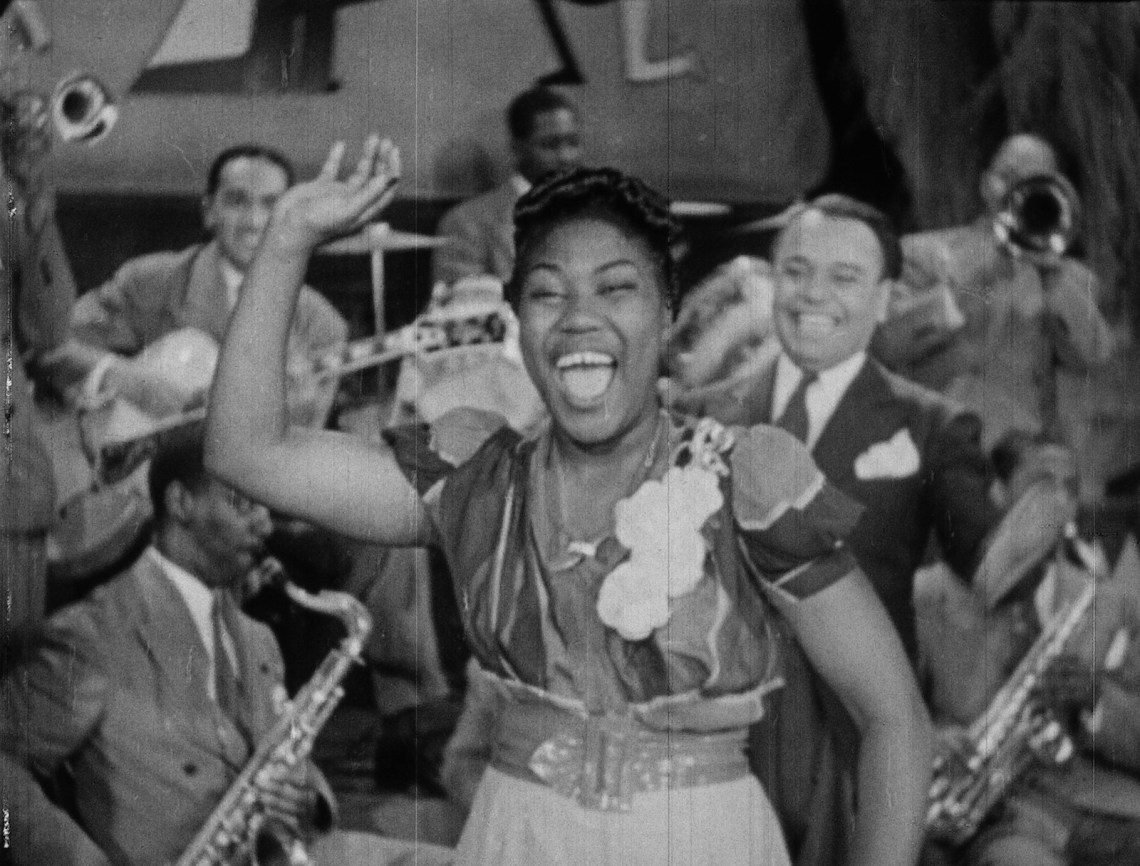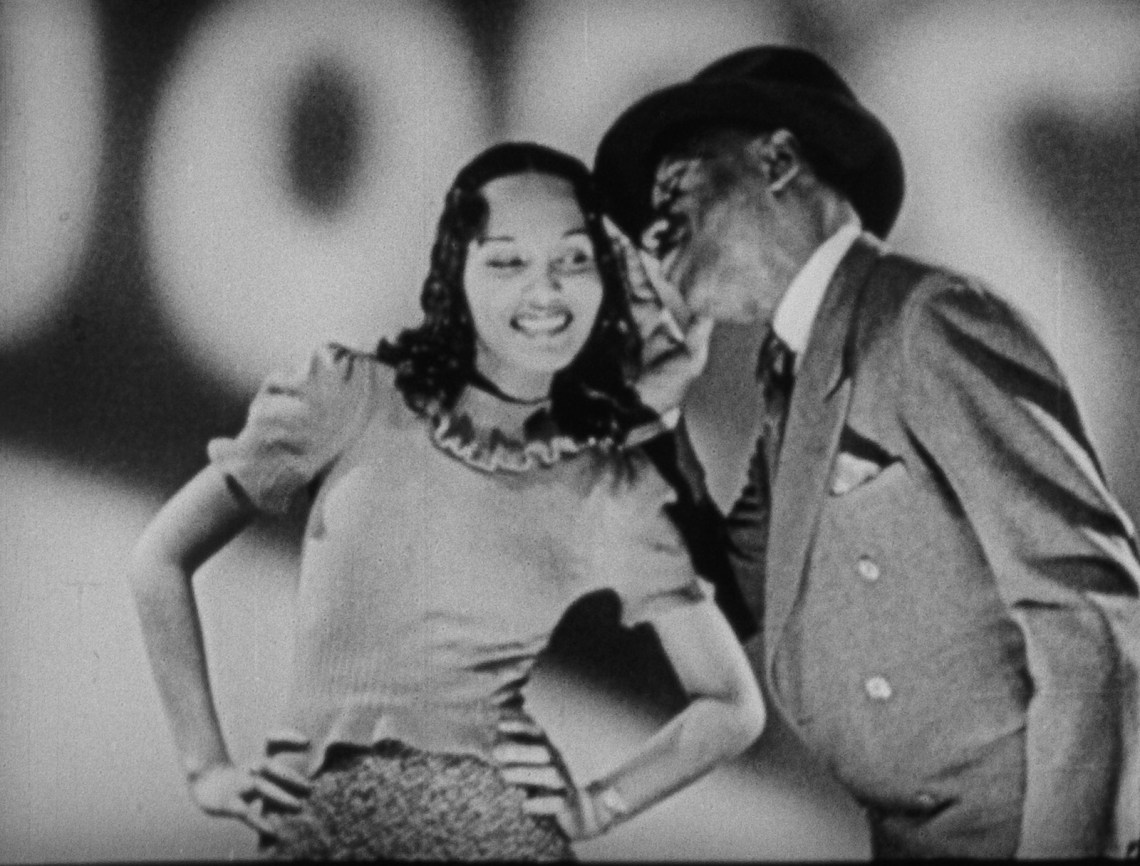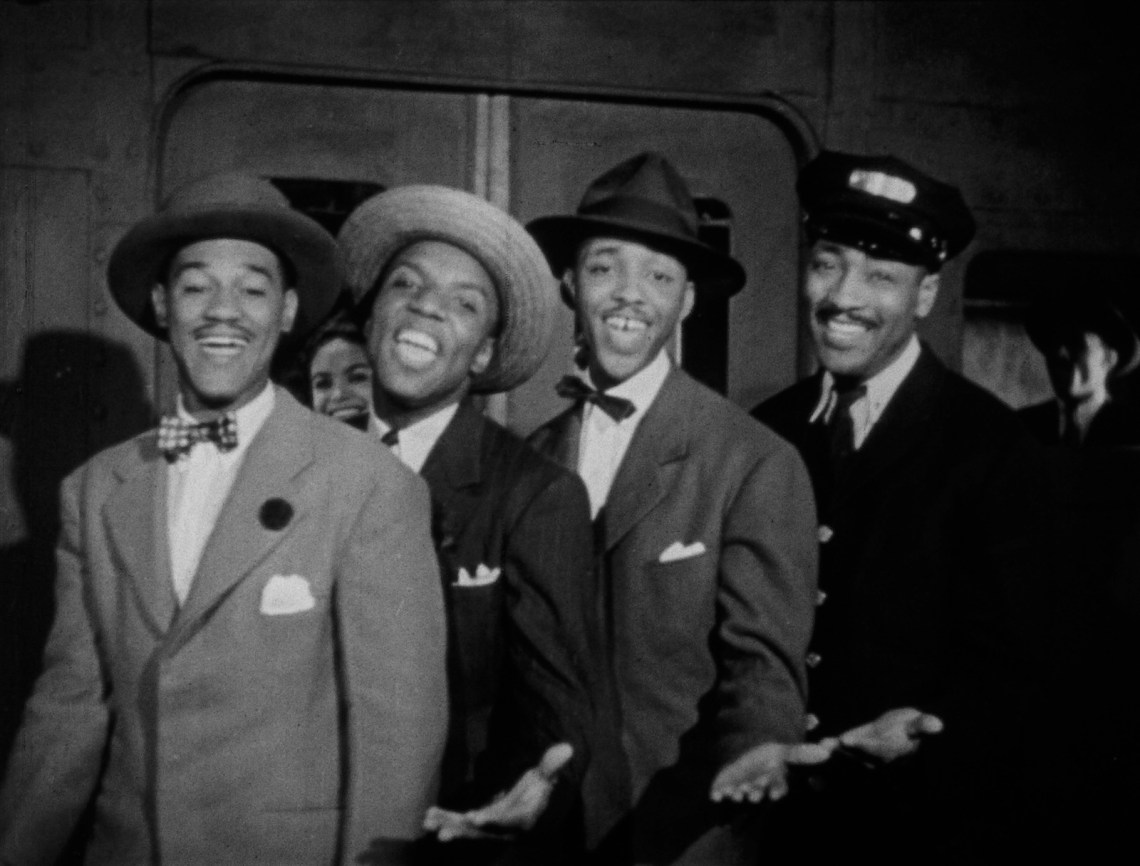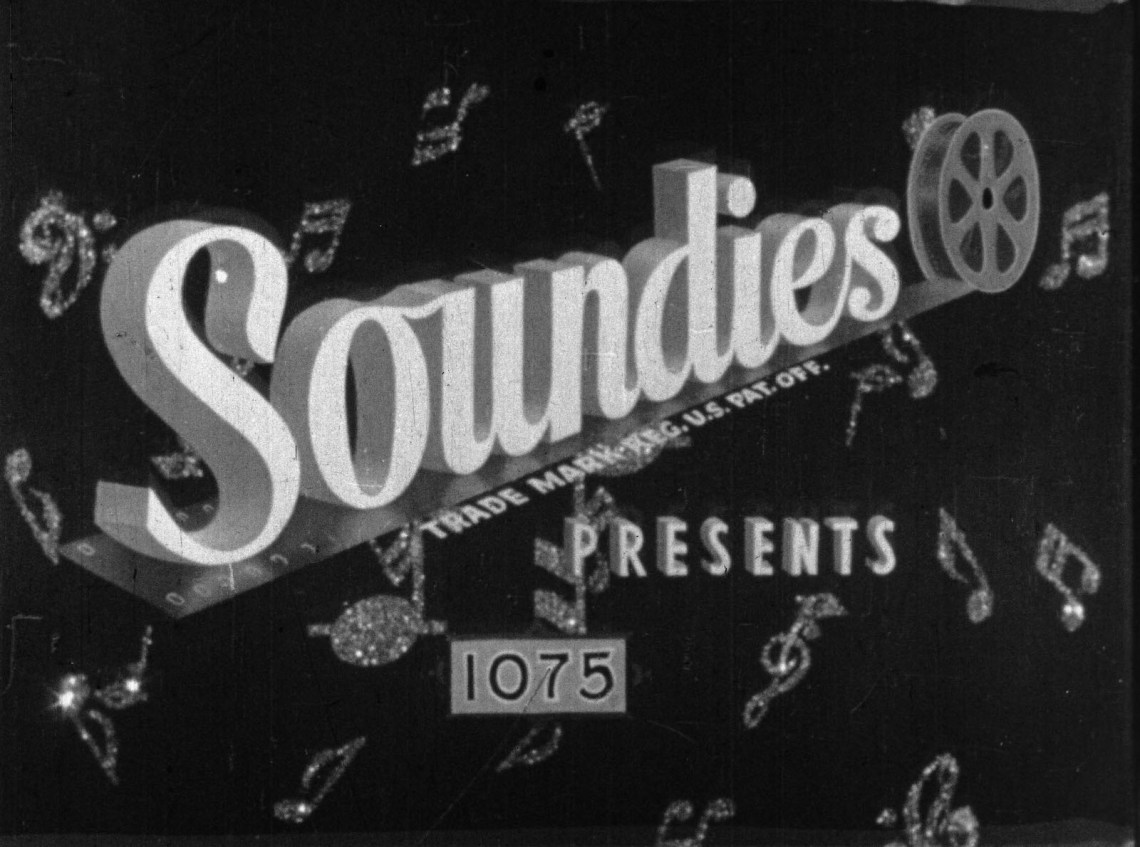“Soundies”—the three-minute musical films made for a bare six years in the 1940s and shown in bars, taverns, and bus stations—are relics of relics. On the one hand, they belong to the century-plus process by which motion pictures traveled from big to little screens and from theaters into life. On the other, they are social hieroglyphs. During their brief life, soundies were as much a part of World War II–era popular culture as zoot suits, Captain America comic books, and early film noir, as well as the Andrews Sisters and the young Frank Sinatra—although neither he nor they ever made one.
Produced in New York, Los Angeles, and Chicago, soundies were an urban form and a Midwestern enterprise. They were distributed on 16mm by the Chicago-based Soundies Corporation of America, released in packages of eight shorts, and exhibited on “panorams,” refrigerator-sized visual jukeboxes—as clunky as Robby the Robot—manufactured by another Chicago firm, Mills Novelty (purveyors of slots and sundry vending machines). Soundies were ambient. People in taverns might watch (or ignore) them from their tables while bar patrons were more likely to dance—at least to the danceable numbers—as they might to a jukebox.
Regular release began, with great fanfare in the show business trades, in January 1941. Every week the Soundies Corporation furnished the nation’s panorams with a new eight-film program—less a precursor to music videos than a throwback to the earliest years of motion picture exhibition, when nickelodeon proprietors would string together a half dozen or more one-reelers to simulate a vaudeville bill. Consumer control was limited. Each play cost a dime, but one would have to go through the entire reel to repeat, for example, nineteen-year-old Dorothy Dandridge singing “Cow Cow Boogie” or the manic pianist Harry Gibson’s eye-rolling version of “Harry the Hipster,” both among the nearly two hundred examples of the form included on the four-disc Blu-ray set Soundies: The Ultimate Collection, curated by the cultural historian Susan Delson, author of the authoritative study Soundies and the Changing Image of Black Americans on Screen: One Dime at a Time.1
By 1947 the phenomenon was largely over, having produced close to two thousand little movies, some of which got a second life on early television broadcasts—the medium often blamed for the soundies’ demise. (The format was revived in Europe in the 1960s via the Scopitone.) At their height, soundies were distributed to three thousand panorams, mostly but not exclusively located in northeastern cities. The Soundies Corporation had hoped to serve ten times as many locations, but in the spring following the attack on Pearl Harbor, as Delson notes in the set’s informative booklet, “the federal government halted all jukebox manufacture” to ration essential war materials. Curtailing further expansion may have had the unintended effect of minimizing the segregationist Southern market and allowing greater attention to the Black artists who were the medium’s not-so-secret stars (and who sometimes disparaged Dixie while extolling the freedom afforded by Harlem).
Despite this government interference, soundies were more than pleased to wave the flag and boost national morale. Humble agents of hegemony, made by marginal Hollywood types and musical trendspotters targeting a war-mobilized national audience, soundies intrinsically sought to stir remnants of surviving folk culture into the pop patriotic stew. In I’m an Old Cowhand (1941), the vaudeville veteran Gus Van sings Italian-, Irish-, and Russian-accented versions of a comic song written by Johnny Mercer for the 1936 Bing Crosby vehicle Rhythm on the Range. In Take Me Out to the Ball Game (1945), the Polish Chinese Kim Loo Sisters syncopate another national anthem, addressed to a table of Asian GIs. Dressed as cowpokes, Johnny Moore’s Three Blazers harmonize with Johnny “Shadrach” Horace for an audience of three African American señoritas in Along the Navajo Trail (1945).
Each soundie is a miniature show-business episode. Pan-Americonga (1941) is sensationally danced by the all-purpose “ethnic” singer and perpetual motion machine Rita Rio (aka Dona Drake). Other mad mash-ups include Jitterbug Senorita (1941), Cowboy Calypso (1946), and Jive, Little Gypsy, Jive (1941). Along with exhibitions of yodeling, square dancing, polka, and acrobatic dogs, there are truly fantastic demonstrations of the acrobatic Lindy Hop, skirts flaring, legs wrapped around torsos, partners hoisted in the air. “Swing”—present in Western, Rhumba, and Yiddish iterations—was the magic word, and big bands the preferred orchestration. The Ultimate Collection includes soundies featuring the Duke Ellington, Count Basie, and Gene Krupa orchestras along with countless mediocrities.
Advertisement
There are two excellent all-female swing ensembles. The eponymous leader of Thelma White’s All-Girl Orchestra, an impressively kinetic conductor in Take It and Git (1946), was a circus girl, vaudeville veteran, silent movie comic, and featured good girl in the 1936 anti-dope cheapster Reefer Madness. She’s Crazy with the Heat (1946), featuring the racially integrated International Sweethearts of Rhythm, was produced by William D. Alexander, then working for the Office of War Information producing the “All-American News,” newsreels aimed at Black audiences concerning African American servicemen.
The hunt for auteurs yields two erstwhile independent filmmakers, Dudley Murphy (who directed Paul Robeson in the 1933 film of The Emperor Jones) and Josef Berne (director of the Yiddish talkies Mirele Efros and Catskill Honeymoon and the independent Spanish-language production La Vida Bohemia), as well as the enigmatic Reginald LeBorg (né Harry Reginald Groebel). Born in Vienna, LeBorg landed in Hollywood in the early 1930s. Hollywood society reports variously identify him as a banker, a former associate of Max Reinhardt, and a concert pianist. Having been one of the first to jump on the soundies bandwagon, he went on to enjoy a long career directing low-budget horror films.
More than nascent directors, The Ultimate Collection yields early recordings of future entertainment titans like Liberace and Doris Day, not to mention Jimmie Dodd, later the head Mouseketeer on the original Mickey Mouse Club. The smarmy yet genteel Pin-Ups on Parade (1944) provides a quick glimpse of a sultry, uncredited Gloria Graham. Dance, Baby, Dance (“Tantze Babele”) from 1945 offers the sound of Mel Tormé singing in Yinglish. The wartime mentalité is evinced by the abundance of gentle and not-so-gentle army gags and the occasional stern public service message. Frances Faye: I Shut My Mouth for Uncle Sam (1942).
The enthusiasm expressed in the drinking songs is notable for a country that had recently lived through a period of enforced abstinence. Soundies were subject to intermittent local censorship (Pennsylvania and Ohio seem to have been particularly vigilant, Milwaukee required that individual films be licensed), but they recall the raciness of pre-Code movies, flaunting so much leg that the visual jukebox might have been named the “Gam-o-Ram.” Breaking a Hollywood taboo, one soundie ends with a couple jumping into bed. Another includes a bridal striptease. Drag acts feature in a half dozen soundies here. On the Boulevard (1946) employs what could only be described as a hermaphroditic chorus line, while for some viewers Too Many Sailors (1944)—with women dressed as sailors pursuing a hot lindy-hopper for an appreciative male audience—might verge on the pornographic.
*
Delson’s curation is creative. In addition to various thematic groupings (including “The Home Front,” “Outrageously Incorrect—and Sometimes Subversive,” and “Jumping into Gender Play”), she includes four actual eight-soundie programs for context. She also appears intermittently to offer commentary, sometimes with the filmmaker and conservationist Ina Diane Archer, but her strongest points are made through juxtaposition. The introductory section basically alternates Black bands and performers with white ones, allowing viewers to draw their own conclusions about the origins and virtuosi of American entertainment.
Black artists were present in most weekly reels. They were also—according to the media scholar Ellen C. Scott, who has an essay in the booklet—the most likely to be censored. With his outrageous mugging, Fats Waller was made for soundies, while Dorothy Dandridge was arguably the greatest of soundie-made stars. (Her white equivalent was the perky singer and 1950s sitcom star Gale Storm.) Like Waller and Dandridge, the high-energy vocalists Louis Jordan and Sister Rosetta Tharpe appear more than once, as do super-cool Nat King Cole, the cabaret cut-ups Day, Dawn, and Dusk, and the forgotten boogie-woogie virtuosos Maurice Rocco and Lynn Albritton, seen in Dispossessed Blues (1943). A demonstration of what might have been possible in a truly integrated Hollywood, Take the ‘A’ Train (1941) with the Delta Rhythm Boys is close to a masterpiece of 1940s pop culture.
As a form, soundies were relatively integrated. As individual films, most were not. (Calypso numbers are invariably performed by whites for whites.) One of the handful that were, Let Me Off Uptown (1942), has the Krupa band’s star trumpeter, Roy Eldridge, riffing with the convincingly hip (and racially ambiguous) Anita O’Day. Remarkably, it escaped censorship, although the more amazing Shoeshiners and Headliners did not. Possibly produced by the Austrian director Friedrich Feher, who had appeared some twenty years before in The Cabinet of Dr. Caligari, this 1941 dance routine opens with an unsubtle, if unconscious, allegorical image of American show business before plunging deep into libidinal fantasy. In an energetic line, seven African American men shine the shoes of (and provide rhythm for) a row of seated white horn players. After a minute or so the set is invaded by a chorus line of sprightly young white women in newsboy caps and short shorts singing that “all the news that’s fit to print is seldom fit to read.” Say what? It ends in a chaste orgy of mass twerking complete with intimations of interracial bottom-bumping. According to Delson, eighteen seconds were cut in Ohio. As reasons for censorship were generally vague, Delson coyly invites the viewer to imagine what was cut and why.
Advertisement
To use a term that migrated from Black slang to general usage during the 1940s, Soundies: The Ultimate Collection is a deep dig. Delson’s excavation of indigenous Americana is in some ways comparable to Harry Smith’s foundational Anthology of American Folk Music. Like Smith’s Anthology, if less eccentrically, her Ultimate Collection is a typological arrangement of found material. But while the Anthology was steeped in the vernacular, drawing on musical recordings from a period when, unsure of their market, record companies captured anything and everything, Soundies charts the effacement of regional culture begun by radio and talking pictures. Rather than evidence of the Old Weird America that Greil Marcus found in the Anthology, it collects the artifacts of a Once-New Surreal America that was promoted by classic Hollywood in its tireless attempt to forge a universal audience. Still, the two projects are not unrelated. Smith’s Anthology jump-started the folk music revival of the 1950s. Soundies, while less world-historic, could still resonate. Not just nostalgia buffs or cultural historians but TikTokers will find much to mine here.
